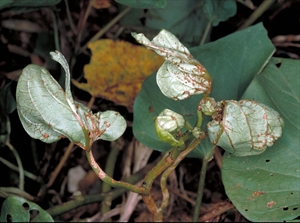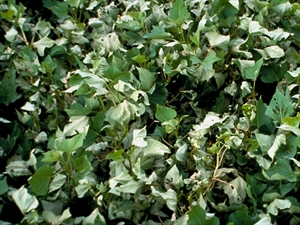- Worldwide distribution. On sweetpotato. A common, and sometimes serious fungal disease.
- Worse in wet weather.
- Young leaves infected early, especially along veins causing them to distort as they expand.
- Spread is by water splash, wind-driven rain, and on planting material.
- Cultural control: tolerant varieties, which exist in most countries. If susceptible varieties are needed, grow cuttings from sweetpotato storage roots, in a nursery far from production areas.
- Chemical control: mancozeb when symptoms first occur, but likely to be uneconomic.
Pacific Pests, Pathogens and Weeds - Online edition
Pacific Pests, Pathogens, Weeds & Pesticides
Sweetpotato scab (013)
Sweetpotato scab
Elsinoe batatas, but sometimes known as Sphaceloma batatas (the asexual stage). Usually, only the asexual state is seen on the leaves.
AUTHORS Helen Tsatsia & Grahame Jackson
Information from Jackson G, McKenzie E (1991) Pest Advisory Leaflet 24. South Pacific Commission, Noumea, New Caledonia. (https://lrd.spc.int/component/docman/cat_view/137-all/128-plant-health-/276-pest-advisory-leaflets?start=40); and from Ekman J, Lovatt J (2015) Pests, Diseases and Disorders of Sweetpotato: A Field Identification Guide. (https://www.soilwealth.com.au/imagesDB/news/Sweet-Potato-Pest-and-Disease-Guide.pdf). Photo 2 John Bokosou, NARI, Papua New Guinea.
Produced with support from the Australian Centre for International Agricultural Research under project PC/2010/090: Strengthening integrated crop management research in the Pacific Islands in support of sustainable intensification of high-value crop production, implemented by the University of Queensland and the Secretariat of the Pacific Community.






